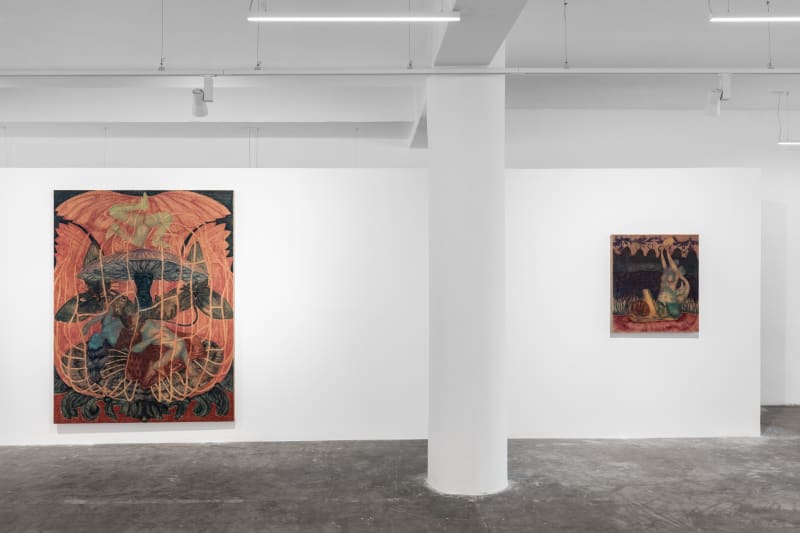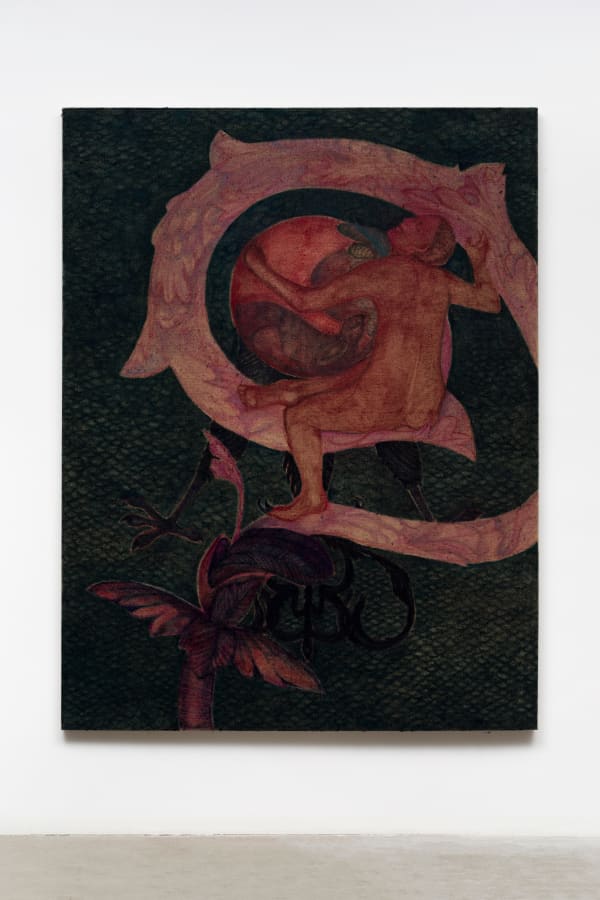Proscenium Victor Bengtsson
Past exhibition
Overview
Mendes Wood DM is pleased to present Proscenium –- Danish artist Victor Bengtsson's first solo show in Brazil. The exhibition brings together five paintings made in São Paulo, mapping relationships between mythology, bodily fluids, and mental states. Bengtsson uses jute as material support for his canvases in an attempt to remove the glossy aspect of oil painting, instead bringing to remove its greasy character from the oil, bring a rougher aspect to his painting, and in addition to reducing the light as much as possible. As a result, the images are anachronistically powerful. This historical shift to to representing fantastical mythological images of mythologies under in a raw pictorial intention manner brings results in a unique balance between drama and contemplation to in the artist's figuration.
Proscenium is the name given to the specific place between the arches of the a stage and the audience in a theater. The scenes depicted in Bengtsson's paintings evoke a tragic atmosphere, almost like the settings for a play that introduces us to four temperamental human emotional states –- Sanguine, choleric, melancholic, and phlegmatic. In 400 BC, Hippocrates described 400 years BC how these four temperaments resulted from an the excess of a particular bodily fluid. Throughout history, the four temperaments have been compared with the four elements – Earth, Water, Fire, and Air. Galen of Pergamon has described these temperaments concerning the in relation to four bodily fluids as well as about these and these four elements. The ancient Greco-Roman theory about the four types of temperaments served as a source for creativity in of inspiration throughout art history, and it is represented in paintings, musical compositions, and ballets. These representations are the artist’s starting point for the artist to develop his painting.
The artist Bengtsson relates, for example instance, Melancholia the melancholic with black bile, a mixture of blood and bile. Furthermore, the element is earth,The Earth element is illustrated by the mushrooms, mycelium, and dark lilies, commonly present at found at Western funerals in western societies. The faces on the mushrooms are a reference to the mushroom stone sculptures in Mayan culture. The feet-triskelion at the top of the painting is trapped by a gray yarn holding it up. All these scenes come from films, literature, and ancients’ imagery. While for theThe element linked to the Phlegmatic , the element is water. The animal is an ox and, is in the painting, it is seen as part of a floating boat-like structure onto which where the a person is sitting. The head of the ox, inspired by the Greek myth of the Minutaurus Minotaur –, who a creature with had the head of an ox and the body of a man –,, carries an evokes the imminent drama for in Bengtsson's work.
His bucolic narratives are celebrations of flora and fauna in a digital age, imagined fairy tales in which humans and animals surrender to their natural surroundings. Born in Copenhagen, Bengtsson studied fine arts at the Vera School of Art and Design and at the Krabbesholm Højskole, before finally working and training as a doctor. The changing seasons in his home country of Denmark, exceptionally particularly the fleeting northern summers and wintertime melancholy for warmth, underlie his interest in depicting our relationship with nature. The Pre-Raphaelites are an apparent clear influence on Bengtsson, whose sinuous forms, plant forms shapes, and elongated figures also recall the aesthetics of Art Nouveau. His work also draws on the idyllic scenes of Danish Golden Age painting, too, while the poetry of Morten Nielsen inspires and the titles for many of Bengtsson's creations of many of his creations. Elegant forms and subdued color characterize this young artist's work, who uses thin layers of undissolved oil paint on untreated jute or canvas to achieve an earthy effect.
Proscenium is the name given to the specific place between the arches of the a stage and the audience in a theater. The scenes depicted in Bengtsson's paintings evoke a tragic atmosphere, almost like the settings for a play that introduces us to four temperamental human emotional states –- Sanguine, choleric, melancholic, and phlegmatic. In 400 BC, Hippocrates described 400 years BC how these four temperaments resulted from an the excess of a particular bodily fluid. Throughout history, the four temperaments have been compared with the four elements – Earth, Water, Fire, and Air. Galen of Pergamon has described these temperaments concerning the in relation to four bodily fluids as well as about these and these four elements. The ancient Greco-Roman theory about the four types of temperaments served as a source for creativity in of inspiration throughout art history, and it is represented in paintings, musical compositions, and ballets. These representations are the artist’s starting point for the artist to develop his painting.
The artist Bengtsson relates, for example instance, Melancholia the melancholic with black bile, a mixture of blood and bile. Furthermore, the element is earth,The Earth element is illustrated by the mushrooms, mycelium, and dark lilies, commonly present at found at Western funerals in western societies. The faces on the mushrooms are a reference to the mushroom stone sculptures in Mayan culture. The feet-triskelion at the top of the painting is trapped by a gray yarn holding it up. All these scenes come from films, literature, and ancients’ imagery. While for theThe element linked to the Phlegmatic , the element is water. The animal is an ox and, is in the painting, it is seen as part of a floating boat-like structure onto which where the a person is sitting. The head of the ox, inspired by the Greek myth of the Minutaurus Minotaur –, who a creature with had the head of an ox and the body of a man –,, carries an evokes the imminent drama for in Bengtsson's work.
His bucolic narratives are celebrations of flora and fauna in a digital age, imagined fairy tales in which humans and animals surrender to their natural surroundings. Born in Copenhagen, Bengtsson studied fine arts at the Vera School of Art and Design and at the Krabbesholm Højskole, before finally working and training as a doctor. The changing seasons in his home country of Denmark, exceptionally particularly the fleeting northern summers and wintertime melancholy for warmth, underlie his interest in depicting our relationship with nature. The Pre-Raphaelites are an apparent clear influence on Bengtsson, whose sinuous forms, plant forms shapes, and elongated figures also recall the aesthetics of Art Nouveau. His work also draws on the idyllic scenes of Danish Golden Age painting, too, while the poetry of Morten Nielsen inspires and the titles for many of Bengtsson's creations of many of his creations. Elegant forms and subdued color characterize this young artist's work, who uses thin layers of undissolved oil paint on untreated jute or canvas to achieve an earthy effect.
Works
Installation Views




